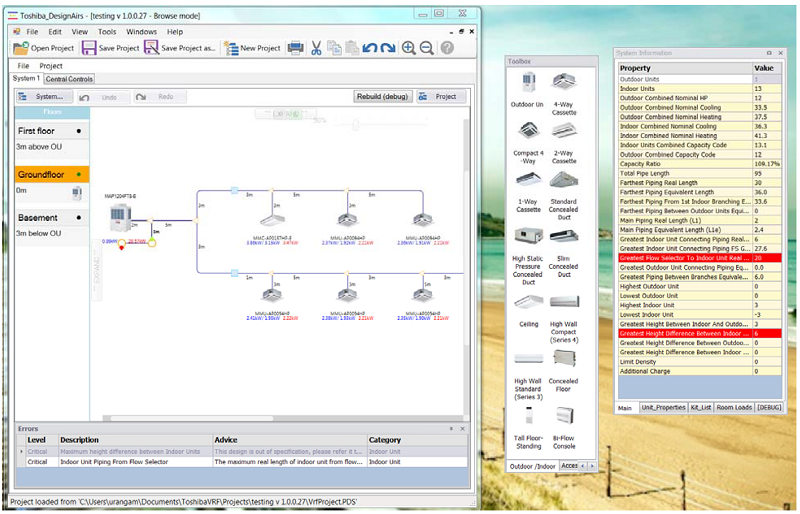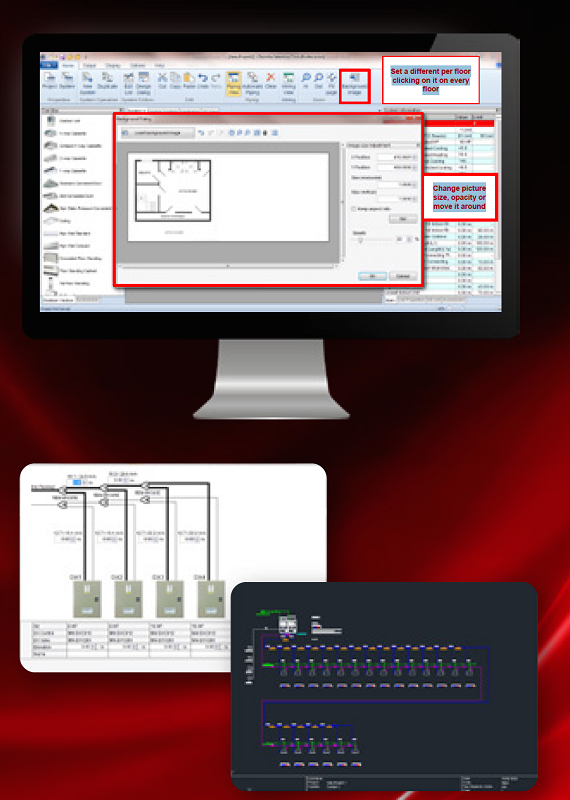Toshiba has released a new generation of its air conditioning system design softwarewhichfor the first time enables contractors to carry out both split and VRF system selections and automated EN378F-Gas compliance checks.
DesignAIRS was originally developed by Toshiba in Europe, andthe company recently adopted the system as its global air conditioning design platform, developing and rolling out a completely updated version of the software.While the first generation of DesignAIRS covered only VRF systems, the latest version enables a range of technologies to be added to designs, including split systems, heat recovery, hot water modules and DX-based air handling units, dramatically expanding its application.
In addition to automatically evaluating compliance with mandatory refrigerant safety standards, the new programme simulates true system capacity for designs.This assures clients and end usersthat a proposed solution will meet both statutory and project performance requirements.
Oliver Sanders, TCUK’s pre-sales manager who leads digital project design support, said: “The majority of projects today include a variety of air conditioning technologies rather than being reliant on a single approach. The new package enables contractors and consultants to design systems that take account of the complex requirements of real buildings and how they are used, and optimise performance and efficiency across the piece, taking into account all the equipment involved.”
In addition to creating detailed project drawings for a variety of building types, including pipework and equipment specifications, the new versionincludes a seasonal performance calculator that allows designers to simulate the actual performance and running costs of a system using local seasonal temperatures and operating conditions.
Different tarrifs can be used for the calculationsto estimate running costs under alternative supply contracts. Designers can simulate the anticipated running costs of a system for end users, and how much CO2 it will produce in a year.
Air conditioning designers can now also import building floorplansand use them as background layouts, assisting clients and installers to visualise the completed system as installed within the building.
The software can be downloaded here: http://www.toshiba-calc.co.uk/vrf_design.zip
11 April 2019
New Generation of Design Software Automates Refrigerant Compliance and Capacity Calculations
Related news
Embraco expands into HVAC market with scroll compressor acquisition
Nidec Global Appliance has announced the expansion of its Embraco brand into the heating and air conditioning (HVAC) market through the acquisition of scroll compressor manufacturer Xecom. Th...
09 Jul 2025
Johnson Controls expands Denmark heat pump plant to meet global demand
Johnson Controls has begun construction on an expansion of its Holme heat pump and chiller facility in Aarhus, Denmark. The site, which produces high-capacity commercial and industrial heat pumps, ...
10 Jul 2025
Beijer Ref has introduced a CO2-based ice builder developed in New ...
Beijer Ref has introduced a CO2-based ice builder designed and developed in New Zealand, which the company says is the first of its kind in the region. The system is intended for dairy industry app...
03 Jul 2025
Nordic Climate Group acquires Climanova, enters Belgium market
Nordic Climate Group has acquired Climanova, a Dutch-Belgian company specializing in cooling, climate control, and heating systems. The acquisition expands the Group’s operations in the southwest o...
yesterday
LG targets global HVAC leadership with data center and regional B2B...
LG Electronics has outlined its strategy to become a top-tier global provider of heating, ventilation and air conditioning (HVAC) solutions by 2030. At a press conference held on July 8 at LG Scien...
yesterday
Caverion Austria acquires Lepuschitz Kältetechnik GmbH
Caverion Austria has acquired Lepuschitz Kältetechnik GmbH, a refrigeration specialist based in Wernberg, Carinthia. The acquired company employs 18 people and generates annual revenue of approxima...
01 Jul 2025

